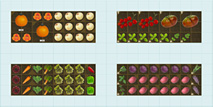How to grow Collards?
- Latin Family: Brassicaceae
- Latin Genus: Brassica
- Ease of Growing: Easy
- Growing Type: Annual
Collards are the same sub-species as Scotch Kale, but differ in being more tolerant of hot weather. Their heat tolerance has made them an important crop in the southeastern states, where they are grown almost year round. Collards are cultivated and used in pretty much the same ways as kale.
Collards History
Collards are one of the oldest members of the cabbage family and is a type of Kale. It has basically remained unchanged for at least 2,000 years. Along the western Mediterranean it has been grown since pre-history. It does well in the wild or forest garden.
Soil Preference
- PH (min/max): 6.0 - 7.5
- PH Ideal (min/max): 6.5 - 7.0
Collards are tolerant of poor soil but the most palatable leaves are produced by rapid uninterrupted growth. For this the soil must be rich and moisture retentive.
It is important that the soil is well drained when growing collards as a winter crop . If the soil is too wet the roots may rot.
How to care for Collards?
Collards are one of the easiest of the Brassica family to grow (as well as one of the most nutritious), and is extremely productive for the work it requires.
Water
Collards must have plenty of water for maximum productivity and best quality.
Fertilizer
Low nitrogen. Moderate potassium. Moderate phosphorous.
Collards have similar nutritional requirements as kale, in that it needs a significant amount of phosphorus and potassium, but not a lot of nitrogen. It will flower early with too much nitrogen.
Seeds
Seed Viability: 4 - 6 years
Germination Percentage: 75.0
Collards are biennial and will cross-pollinate with any other Brassica crop (broccoli, brussels sprouts, cabbage, kale), so only one variety should be flowering at one time. Collards are usually self-incompatible and must be cross-pollinated by insects. Put seed pods in a paper bags and dry well. Store in cool, dry location.
Light
Sun: min. 6 hours daily
Collards will be most productive in full sun, though they will tolerate partial shade.
Conditions:Cold, Cool, Warm, Hot
Season:Short Season, Long Season
Storage
Collards are best washed, spun dried, leaves laid out in a dish towel and rolled then stored in an air tight bag. They will last 10 days in the refrigerator.
Storage Req: Moist, Refrigerator
Storage Temp: 35-40°F
Storage Length: 1-10 days
Once cooked Collard greens can be frozen for a greater length of time.
Storage Req: Freezer
Storage Temp: 32°F
Storage Length: 1-180 days
Problems
Aphids
These tiny pests are present on most Brassicas in warm weather. The only time they really disappear is when it gets cold. The simplest way to deal with them is to blast them off the plants with a strong jet of water.
They also become a problem when saving seed--for the plant puts more energy into reproduction than in pest prevention.
Collards Types
- Collard Greens
Big, dark green, rounded, slightly savoyed leaves have a mild cabbage-like flavor that improves with a light frost. In mild climates collards will continue to grow all winter without disruption and can be harvested continually for months (it will also be in peak condition in the cool weather).
Pests
- Cabbage Root Maggot
- Deer
- Cabbageworms
- Gophers
- Groundhog
- Slugs and snails
- Aphids
- Birds
- Flea Beetle
- Cutworms
- Thrips
Diseases
- Wirestem
- Clubroot
- Fusarium Wilt
- Blackleg, Aerial Stem Rot
- Damping Off
- Downy Mildew
